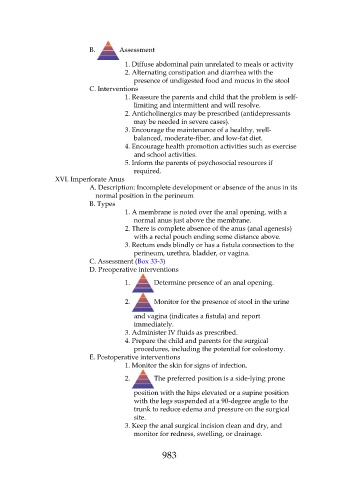Page 983 - Saunders Comprehensive Review For NCLEX-RN
P. 983
B. Assessment
1. Diffuse abdominal pain unrelated to meals or activity
2. Alternating constipation and diarrhea with the
presence of undigested food and mucus in the stool
C. Interventions
1. Reassure the parents and child that the problem is self-
limiting and intermittent and will resolve.
2. Anticholinergics may be prescribed (antidepressants
may be needed in severe cases).
3. Encourage the maintenance of a healthy, well-
balanced, moderate-fiber, and low-fat diet.
4. Encourage health promotion activities such as exercise
and school activities.
5. Inform the parents of psychosocial resources if
required.
XVI. Imperforate Anus
A. Description: Incomplete development or absence of the anus in its
normal position in the perineum
B. Types
1. A membrane is noted over the anal opening, with a
normal anus just above the membrane.
2. There is complete absence of the anus (anal agenesis)
with a rectal pouch ending some distance above.
3. Rectum ends blindly or has a fistula connection to the
perineum, urethra, bladder, or vagina.
C. Assessment (Box 33-3)
D. Preoperative interventions
1. Determine presence of an anal opening.
2. Monitor for the presence of stool in the urine
and vagina (indicates a fistula) and report
immediately.
3. Administer IV fluids as prescribed.
4. Prepare the child and parents for the surgical
procedures, including the potential for colostomy.
E. Postoperative interventions
1. Monitor the skin for signs of infection.
2. The preferred position is a side-lying prone
position with the hips elevated or a supine position
with the legs suspended at a 90-degree angle to the
trunk to reduce edema and pressure on the surgical
site.
3. Keep the anal surgical incision clean and dry, and
monitor for redness, swelling, or drainage.
983

